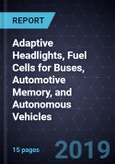This Mobility TechVision Opportunity Engine (TOE) profiles advancements in automotive technologies in adaptive headlights, fuel cells for buses, automotive memory, and autonomous vehicles. Innovations include adaptive headlights for safer night driving, fuel cells, automotive microcontroller memory, airbags, antenna, steering module, pedestrian safety, driver intelligence, advancements in autonomous and passenger vehicles.
The purpose of the Mobility Technology TOE is to raise awareness of global technology innovations in self-propelled ground-based mobile platforms that are not only technically significant, but potentially offering commercial value. Each monthly TOE provides subscribers valuable descriptions and analyses of 10 noteworthy innovations. The main focus is on highway-licensed motor vehicles (light, medium and heavy). Passenger cars, trucks, buses, motorcycles, scooters and railway locomotives are within the product scope, energized by any fuel. Many of the innovations concern powertrains (internal combustion engines, turbines, battery electrics, fuel cell electrics, hybrid-electrics), as well as drivetrains (including transmissions), interiors--seating and displays, advanced materials - as for body/chassis, wireless connectivity, and self-driving technology that is currently receiving so much attention. The A&T TOE outlines and evaluates each innovation, notes which organizations and developers are involved, projects the likely timing for commercialization, furnishes a patent analysis, and provides valuable strategic insights for industry stakeholders.
The Advanced Manufacturing and Automation (AMA) Cluster covers technologies that enable clean, lean and flexible manufacturing and industrial automation. Technologies such as three-dimensional (3D) and four-dimensional (4D) printing, wireless sensors and networks, information and communication technology, multimaterial joining, composites manufacturing, digital manufacturing, micro- and nano-manufacturing, lasers, advanced software, and printing techniques, are covered as part of this cluster. The technologies covered here impact a wide range of industries, such as the impact semiconductor, automotive and transportation, aerospace and defense, industrial, healthcare, logistics, and electronics industries.
Table of Contents
- Adaptive Headlights for Safer Night Driving
- Impact on Sectors
- Fuel Cells for Buses
- Impact on Sectors
- Increasing Automotive Microcontroller Memory
- Impact on Sectors
- Improved Learning for Autonomous Cars
- Impact on Sectors
- External Side Airbags Predict Collisions
- Impact on Sectors
- Antenna Brings HD TV to Recreational Vehicles
- Impact on Sectors
- Collecting Crash Data to Help Physicians
- Impact on Sectors
- 360 Degree Steering Module
- Impact on Sectors
- Pedestrian Detection Solution
- Impact on Sectors
- AI-based Biofeedback Operating System for Cars
- Impact on Sectors
- Forward Driving Assist Technology
- Impact on Sectors
- Connected and Smart License Frame for Passenger Vehicles
- Impact on Sectors
- AI-powered Advanced Vehicle Intelligence Platform
- Comprehensive Protection Against Cyberattacks
- Autonomous Control System for Human-like Navigation
- Impact on Sectors
- Battery-powered Rail-based Vehicle
- Impact across Various Industries and Growth Opportunities
- Key Contacts








